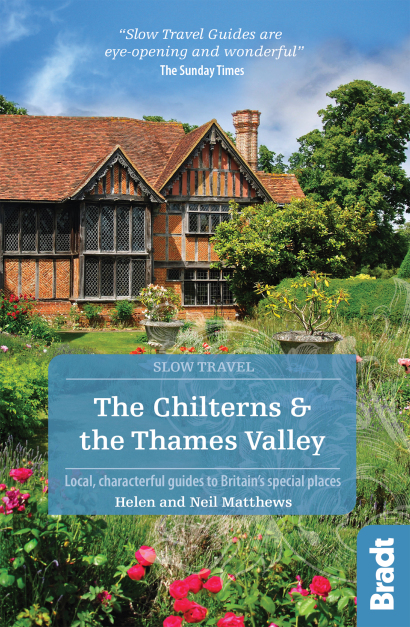For us, the Chilterns means travelling along sunken lanes with dappled sunlight peeking through green tunnels of trees, marvelling at the magic carpets of bluebells which appear in the woods in the spring, followed by orchids on chalk grasslands in the summer.
Helen and Neil Matthews, authors of Slow Travel Chilterns & the Thames Valley: the Bradt Guide
The beauty of the Chilterns & the Thames Valley is that it reveals something different to every holiday-goer willing to take it slow. Some people come for the wildlife hidden in the chalky Chiltern hills, from the red kites that wheel over head all year round to the carpets of orchids that cover the grasslands in the summer. Others arrive in the area to follow in the footsteps of the literary greats, tracing their creative imaginations from the childhood home of Graham Greene in Berkhamsted or the Land of Giants near Roald Dahl’s residence in Great Missenden, to the landscapes along the banks of the Thames that have inspired the likes of T S Elliot and Percy and Mary Shelley.
Away from the hills, the Thames Valley follows one of England’s most famous rivers away from the busy city of London towards more rural attractions. A meander along the Thames takes in highlights such as the royal residence at Windsor and the site of the world-famous Henley Regatta, as well as a sequence of lesser-known villages and market towns, each with its own unique history.
Bradt on Britain – our Slow Travel approach
Bradt’s coverage of Britain’s regions makes ‘Slow Travel’ its focus. To us, Slow Travel means ditching the tourist ticklists – deciding not to try to see ‘too much’ – and instead taking time to get properly under the skin of a special region.
You don’t have to travel at a snail’s pace: you just have to allow yourself to savour the moment, appreciate the local differences that create a sense of place, and celebrate its food, people and traditions.
Food and drink in Chilterns & Thames Valley
It’s a toss-up whether there are more walking routes or choices of excellent food and drink in our region; you’ll need to use the former, in order not to put on too much weight from sampling the latter.
There isn’t a single food or dish synonymous with the area in the same way as a Lancashire hotpot or a Devon cream tea – though we’re fond of a bacon badger. But some traces of local food heritage remain. Aylesbury ducks are its noisiest manifestation. This distinctive bird is on the menu (order it when you book your table) at the King’s Head in Ivinghoe. Sadly, most of the cherry orchards have disappeared, but examples of heritage cherries remain at the Chiltern Open Air Museum and there’s an annual Cherry Pie Fair in Seer Green, near Beaconsfield. Keep your eyes peeled, too, for the Aylesbury prune, a blue-black variety of damson plum. The chalk streams in which the region is so rich enabled the growth of the watercress industry, and you can find and taste the produce of the last operating commercial watercress centre in the country.
Happily, there’s a small army of local independent producers across the region today, working hard to bring you a range of wonderful taste sensations. The fifth and sixth generations of Darvells are a mainstay of Chesham with their handmade bread and cakes; Zanni’s, an organic farm based just outside Aylesbury, specialise in sourdough products that sell in shops and farmers’ markets across the region. Wobbly Bottom Farm near Hitchin is well known for its soft and hard goat’s cheeses; Nettlebed Creamery near Henley has won awards for its St Bartholomew and Bix cheeses since starting production in 2015; and we have a soft spot for Marlow Cheese Company’s produce.
You might find it hard to walk past the Pangbourne Cheese Shop without sampling their extraordinary range of stock. If you’re a fan of pickles, chutneys and other preserves, Jim and Jules Big Adventure of Cheddington will probably have just the thing. For a sweet or savoury nibble, Just Biscuits from Stoke Mandeville are hard to beat, as are the salamis and air-dried meat of Chiltern Charcuterie, who use pork, beef and lamb from local independent farms. Boarstall Meats use their own onfarm butchery to prepare beef, lamb, pork and poultry, while Chiltern Farm Food in Coleshill, near Amersham, specialises in traditional breeds of sheep and pigs, with their 130-acre farm also providing rabbit, venison and pigeon and a seasonal shoot supplying pheasants, duck and partridge.
On a sweeter note, if you’re in a local cinema or theatre, you’ll probably find ice cream from Beechdean, founded in 1989 and now the UK’s third-largest ice cream manufacturer. Local cafés, farm shops and other outlets frequently stock ice creams, sorbets and gelato from Chiltern Ice Cream Company; their rhubarb ripple ice cream is well worth seeking out.
Local farm shops are an excellent source of these and other artisan foods, including their own products. We always enjoy visiting P E Mead near Tring, Peterley Manor Farm in Prestwood, The Herb Farm and Orchard View Farm near Princes Risborough. The Buckmoorend Farm on the Chequers Estate focuses on pork, beef and lamb, while the Littlecote Farm Shop near Winslow supplies duck and goose eggs, oils, preserves and much else. The Royal Windsor Farm Shop sells meat and eggs from the Windsor Estate; it may also be the only farm shop where you can buy a toy corgi. Or you can pick up produce at one of the many farmers’ markets around the region.
Local producers
The food and drink scene in the Chilterns wouldn’t be complete without the local independent producers which make it something really special. There are good quality makers of sweet treats and desserts all over the region. Anne and Ian Scott, owners of the luxury ethical chocolate company Auberge du Chocolat, sell their delicious products out of their shop based in Chesham, and they also offer an exciting range of chocolate crafting workshops. Nanna’s Christmas Pudding, near Dunstable, produce traditional puddings and cakes following tried and tested family recipes passed down over three generations. Other regional highlights include Victoria Bell’s hand-crafted fudge business Peaches and Cream Fudge and Blossoms Syrup, a good quality supplier of fruit syrups.
Drinking The Chilterns & the Thames Valley
An impressive array of breweries and micro-breweries has established itself across the region. The Chiltern Brewery is probably the oldest, having started in 1980 when micro-breweries were rare nationally as well as locally, while Malt the Brewery is one of the newest, opening in 2012 on a farm in Prestwood. Potten End near Berkhamsted is home to the self-styled ‘unhinged beers’ of Mad Squirrel, with additional venues in Amersham, Berkhamsted town centre, Chesham and High Wycombe. You could opt for the produce of Rebellion Beer in Marlow or the Tring Brewery, whose range includes the intriguingly named Side Pocket for a Toad.
If wine is your tipple of choice, there are several options. In the wonderful setting of the Hambleden Valley, the Chiltern Valley Winery & Brewery produces both beer and wine. White, rosé and sparkling wine are produced and bottled on site at Frithsden Vineyard, where the first vines were planted in 1971. The Daws Hill Vineyard just outside High Wycombe specialises in sparking white and red wines and cider.
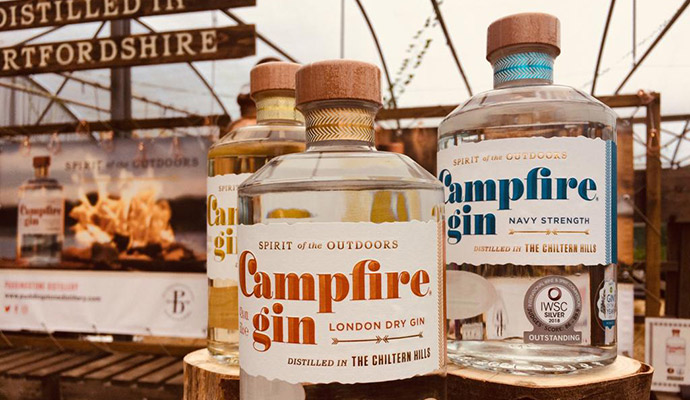
Recent years have seen the growth of gin and spirit enterprises in the region. Puddingstone Distillery near Tring, the first gin distillery in Hertfordshire, attempts to capture the spirit of the outdoors with its Campfire Gin, while Griffiths Brothers, based in Penn Street, uses cold distillation as the basis for their production.
The Foxdenton Estate in north Buckinghamshire, home to the Radclyffe family for over 500 years, focuses on English fruit gin liqueurs using raspberry, damson, rhubarb and plum, and London dry gin. By way of contrast, the 17th-century science of apothecaries is the inspiration for Seedlip, which Ben Branson founded in his kitchen in the heart of the Chilterns. The company describes its products as the world’s first distilled non-alcoholic spirits.
Tours, tastings and the chance to stock up in the brewery shop are a common feature of many of these outlets. You can also find many of the products listed above in local – and sometimes national – shops, cafés, pubs and restaurants.
Where to stay in Chilterns & Thames Valley
For information about accommodation, see our list of the best places to stay in the Chilterns & the Thames Valley
What to see and do in Chilterns & Thames Valley
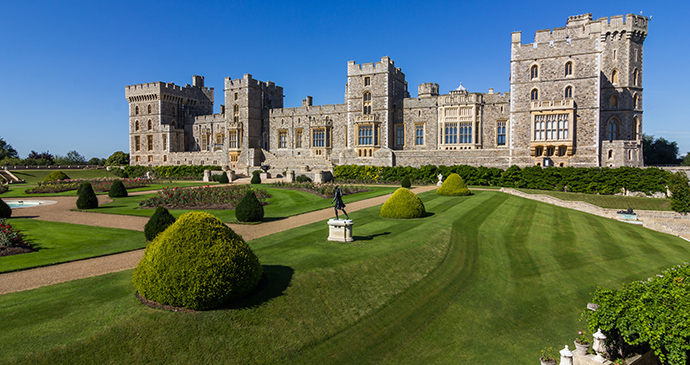 England’s most famous castle, originally completed in 1086, now has more rooms than years it has been standing © Kanuman, Shutterstock
England’s most famous castle, originally completed in 1086, now has more rooms than years it has been standing © Kanuman, Shutterstock
Along The Thames: Runnymede to Marlow
This area follows the Thames as it moves from Surrey through Berkshire and Buckinghamshire, undulating beneath the Chilterns like a cat under a blanket. Its westward journey passes a site which can claim to be the cradle of modern parliamentary democracy, as well as the world’s most famous castle. But the beauty of Slow travel is that, even among such well-known sights, you can take your time and find something unexpected, quirky or beautiful – or all three. There’s a corner of an English great park which is forever Libya; a dolls’ house coming up for its 100th birthday; and the remains of a Bronze Age landscape where rare flowers flourish. You can discover where to walk by the Thames with only sheep and geese for company or unravel the mysteries of ‘swan upping’. This is a region rich in excellent eating experiences in small pubs and internationally renowned restaurants. And great creative imaginations have flourished here, from Stanley Spencer and T S Eliot to Percy and Mary Shelley.
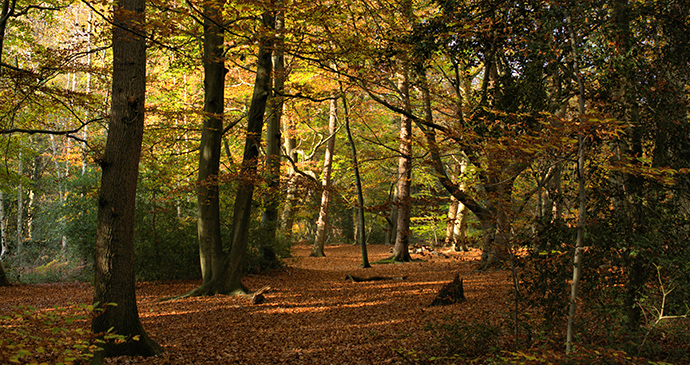 Some of the trees in Burnham Beeches are almost a millennium old © Soulminous, Shutterstock
Some of the trees in Burnham Beeches are almost a millennium old © Soulminous, Shutterstock
Central Chilterns: Stoke Poges to Hambleden
The journey continues south, further into the heart of the Chilterns. If you speak to someone who’s lived around these parts for a long time, they’ll probably mention the word ‘bodger’. The word’s modern meaning is a person or people who somehow cobbles a solution together in a faintly amateurish manner. But being a bodger was once something to be proud of: bodgers played a key role in the industry which defined Wycombe and the surrounding area for generations – furniture making. There’s a great deal of creativity in other respects too (and eccentricity) if you take the time to look round. Some of the woodland, in Burnham Beeches, has probably been the location for filming more famous films and TV series than anywhere else; there’s a mayoral ritual which is unique to Wycombe; and the world’s oldest miniature village is cheek by jowl with the creators of Noddy, the Little Red Fox, Father Brown and Discworld in nearby Beaconsfield. One of Britain’s most famous prime ministers, Benjamin Disraeli, connects the two towns, as he lived at Hughenden Manor just outside Wycombe and later took the title Earl Beaconsfield. Other politicians have added to the eccentric pleasures that await discovery by the curious traveller, with the Dashwoods creating the scandalous Hellfire Caves and an Albanian king hiding out with a stash of gold at Parmoor during World War II. Above all, if you visit this part of the Chilterns, you’ll enjoy some quintessential English rural experiences: eating at the oldest alehouse in the country in Forty Green, watching the ducks on Penn’s pond, looking up from the village green in Turville to admire the windmill or hearing the timeless thwack of leather on willow at Wormsley’s cricket ground.
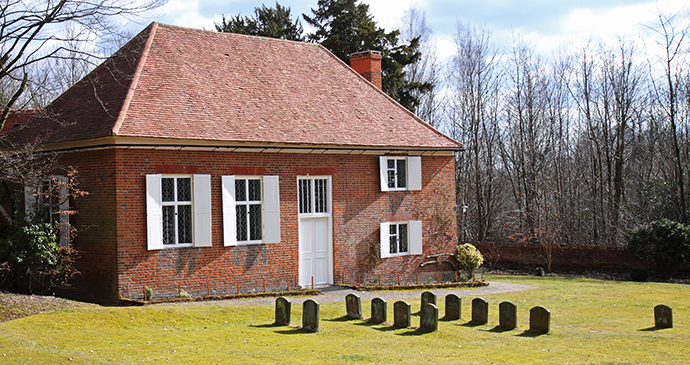 The Quaker Meeting House is a highlight of a visit to Jordans © Chrislofotos, Shutterstock
The Quaker Meeting House is a highlight of a visit to Jordans © Chrislofotos, Shutterstock
Central Chilterns: Wendover to Jordans
Moving south through the Chilterns into its central areas, Bedfordshire and Hertfordshire give way, mostly, to Buckinghamshire. This area covers the stretch of land from Wendover and Princes Risborough in the west to Chesham and Chorleywood in the east. Within this area you can admire an unusual windmill which survives today entirely due to the diligence of volunteers, at Lacey Green; or walk close to a famous country house which the nation’s prime ministers have used for over a century. But there are also memories of dissent and resistance, such as the Hampden Monument and the Martyrs of Amersham. This is the Land of Giants, where you can experience rambunctiousness as a human bean… thanks to Great Missenden’s most famous writer. Starting at the foot of the Chilterns in Wendover, there’s a fair bit of climbing and descending hills involved, but the spectacular views make it well worth your effort.
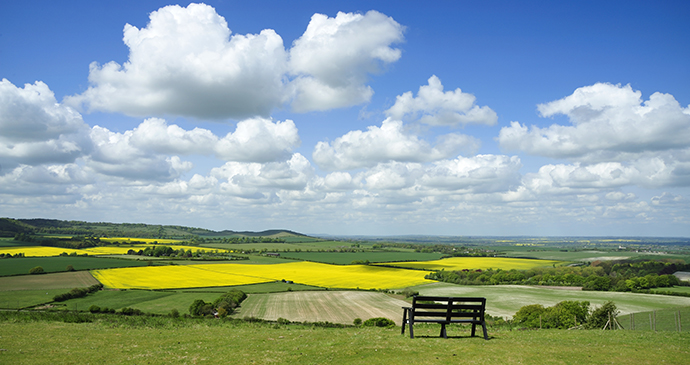 A stunning view over the 5,000 acres of the Dunstable Downs © Alina Wegher, Shutterstock
A stunning view over the 5,000 acres of the Dunstable Downs © Alina Wegher, Shutterstock
Northern Chilterns
This northern area, incorporating parts of central Bedfordshire, Hertfordshire and Buckinghamshire, offers plentiful attractions. There are literary connections from top to bottom, from John Bunyan’s ‘Delectable Mountains’ around Sharpenhoe Clappers to Graham Greene’s childhood home town Berkhamsted. The hat-making trail in Luton and the lavender fields just outside Hitchin give glimpses into the working lives of our ancestors, while memorials at Sharpenhoe and Whipsnade are moving reminders of the Great War. Wildlife flourishes on the 5,000 acres of the Ashridge Estate and the Dunstable Downs, or can be viewed in more static form in Tring’s extraordinary Natural History Museum. Architecture aficionados can enjoy a movie at the Art Deco Rex Cinema in Berkhamsted or admire the medieval wall paintings in Flamstead’s St Leonard’s parish church.
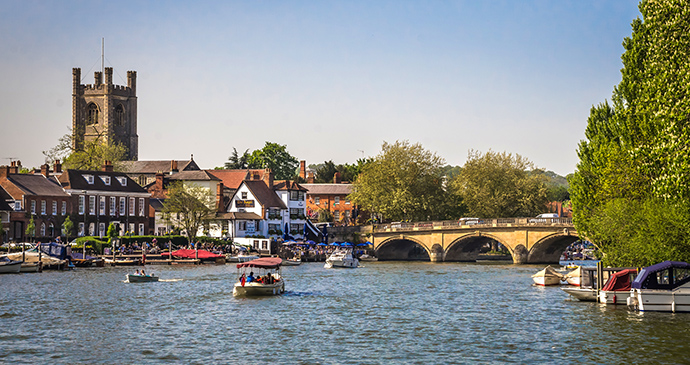
South Oxfordshire & East Berkshire
Starting in Henley-on-Thames, we divert to a trio of intriguing historic properties before following the Thames once more as it winds down to Sonning on the border of Berkshire and Oxfordshire, then turns north, with the Chilterns to the east and the Cotswolds to the west. It makes for a dreamy sequence of little towns and villages, though several have experienced turbulent pasts.
No wonder Kenneth Grahame and Jerome K Jerome chose to spend their latter years around here and to create such seductive worlds in the adventures of Mole, Rat, Badger, Toad and the Three Men in a Boat (and Montmorency, the dog). As you move north towards the Vale of Aylesbury, there are glimpses of Slow travel that were once perceived as not so slow: a heritage railway service and, improbably, one of the world’s biggest motoring names in a barn.
You can also goggle at some of the strangest artefacts of rural life that you’re ever likely to come across, discover the world of watercress and soak up the ambience of one of the Thames’s last remaining unmanicured marshes.
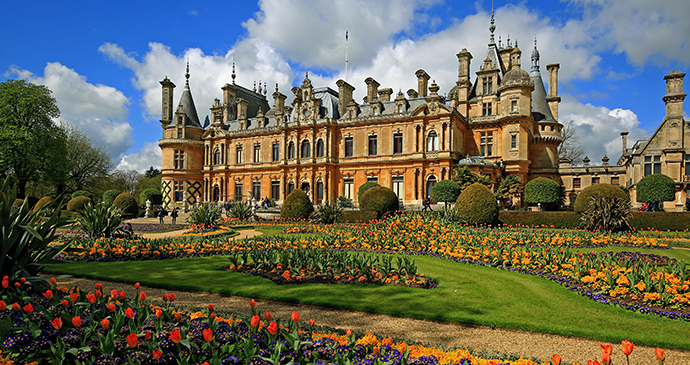 Waddesdon Manor is the best known of all England’s Rothschild houses © Paula French, Shutterstock
Waddesdon Manor is the best known of all England’s Rothschild houses © Paula French, Shutterstock
The Vale of Aylesbury
Leaving Oxfordshire for Buckinghamshire brings you into the Vale of Aylesbury, which rolls even more gently than the Chilterns and is even less crowded – the only Vale towns are Aylesbury, Buckingham and Winslow. The relative openness of the scenery can’t help but be refreshing. The occasional country smell serves as a reminder that there are plenty of working farms round here. It isn’t, strictly speaking, the Chilterns; but visiting the Chilterns and not the Vale of Aylesbury would be like moving into a new house without getting to know your neighbours. We’ve divided the Vale into four sub-sections: the southwest corner; the central southern area around the county town Aylesbury; the northwest, up to and just beyond Buckingham; and the northeast, including a trip over the notional Vale boundary to Leighton Buzzard. There are several historic houses to enjoy, including two of the most extravagant in the southeast of England and maybe England itself – Waddesdon Manor and Stowe – and others in private hands which are just as fascinating, if smaller. The many literary links include the world’s leading wildlife hospital, which takes its name from a Beatrix Potter character, and a clue to the origins of a village from Tolkien’s Middle Earth.
Related books
For more information, see our guide to the Chilterns & Thames Valley:
